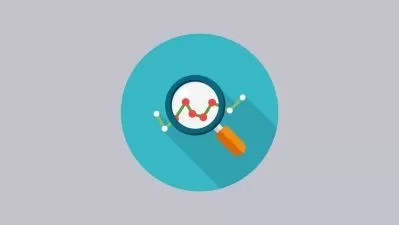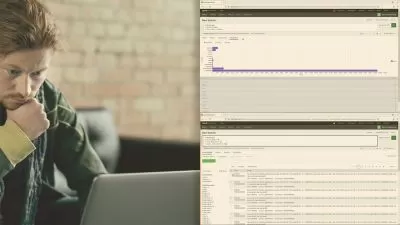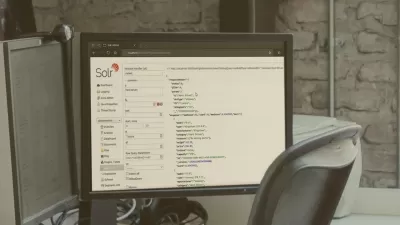Data Science Bookcamp, video edition
Focused View
18:10:38
57 View
1 - Case study 1 - Finding the winning strategy in a card game.mp4
01:46
2 - Chapter 1. Computing probabilities using Python This section covers.mp4
10:24
3 - Chapter 1. Problem 2 - Analyzing multiple die rolls.mp4
11:06
4 - Chapter 2. Plotting probabilities using Matplotlib.mp4
11:05
5 - Chapter 2. Comparing multiple coin-flip probability distributions.mp4
10:59
6 - Chapter 3. Running random simulations in NumPy.mp4
07:11
7 - Chapter 3. Computing confidence intervals using histograms and NumPy arrays.mp4
09:31
8 - Chapter 3. Deriving probabilities from histograms.mp4
10:05
9 - Chapter 3. Computing histograms in NumPy.mp4
09:15
10 - Chapter 3. Using permutations to shuffle cards.mp4
06:36
11 - Chapter 4. Case study 1 solution.mp4
06:54
12 - Chapter 4. Optimizing strategies using the sample space for a 10-card deck.mp4
06:28
13 - Case study 2 - Assessing online ad clicks for significance.mp4
05:09
14 - Chapter 5. Basic probability and statistical analysis using SciPy.mp4
10:09
15 - Chapter 5. Mean as a measure of centrality.mp4
09:29
16 - Chapter 5. Variance as a measure of dispersion.mp4
12:13
17 - Chapter 6. Making predictions using the central limit theorem and SciPy.mp4
08:37
18 - Chapter 6. Comparing two sampled normal curves.mp4
06:53
19 - Chapter 6. Determining the mean and variance of a population through random sampling.mp4
10:14
20 - Chapter 6. Computing the area beneath a normal curve.mp4
09:45
21 - Chapter 7. Statistical hypothesis testing.mp4
06:52
22 - Chapter 7. Assessing the divergence between sample mean and population mean.mp4
07:35
23 - Chapter 7. Data dredging - Coming to false conclusions through oversampling.mp4
09:02
24 - Chapter 7. Bootstrapping with replacement - Testing a hypothesis when the population variance is unknown 1.mp4
08:02
25 - Chapter 7. Bootstrapping with replacement - Testing a hypothesis when the population variance is unknown 2.mp4
08:10
26 - Chapter 7. Permutation testing - Comparing means of samples when the population parameters are unknown.mp4
07:28
27 - Chapter 8. Analyzing tables using Pandas.mp4
10:37
28 - Chapter 8. Retrieving table rows.mp4
08:49
29 - Chapter 8. Saving and loading table data.mp4
07:16
30 - Chapter 9. Case study 2 solution.mp4
07:05
31 - Chapter 9. Determining statistical significance.mp4
06:24
32 - Case study 3 - Tracking disease outbreaks using news headlines.mp4
01:38
33 - Chapter 10. Clustering data into groups.mp4
10:28
34 - Chapter 10. K-means - A clustering algorithm for grouping data into K central groups.mp4
10:16
35 - Chapter 10. Using density to discover clusters.mp4
09:01
36 - Chapter 10. Clustering based on non-Euclidean distance.mp4
07:29
37 - Chapter 10. Analyzing clusters using Pandas.mp4
05:04
38 - Chapter 11. Geographic location visualization and analysis.mp4
08:15
39 - Chapter 11. Plotting maps using Cartopy.mp4
06:07
40 - Chapter 11. Visualizing maps.mp4
12:07
41 - Chapter 11. Location tracking using GeoNamesCache.mp4
11:06
42 - Chapter 11. Limitations of the GeoNamesCache library.mp4
12:04
43 - Chapter 12. Case study 3 solution.mp4
07:15
44 - Chapter 12. Visualizing and clustering the extracted location data.mp4
12:14
45 - Case study 4 - Using online job postings to improve your data science resume.mp4
04:28
46 - Chapter 13. Measuring text similarities.mp4
07:11
47 - Chapter 13. Simple text comparison.mp4
08:54
48 - Chapter 13. Replacing words with numeric values.mp4
08:24
49 - Chapter 13. Vectorizing texts using word counts.mp4
08:36
50 - Chapter 13. Using normalization to improve TF vector similarity.mp4
07:37
51 - Chapter 13. Using unit vector dot products to convert between relevance metrics.mp4
07:15
52 - Chapter 13. Basic matrix operations, Part 1.mp4
09:50
53 - Chapter 13. Basic matrix operations, Part 2.mp4
06:46
54 - Chapter 13. Computational limits of matrix multiplication.mp4
08:09
55 - Chapter 14. Dimension reduction of matrix data.mp4
09:28
56 - Chapter 14. Reducing dimensions using rotation, Part 1.mp4
07:14
57 - Chapter 14. Reducing dimensions using rotation, Part 2.mp4
06:15
58 - Chapter 14. Dimension reduction using PCA and scikit-learn.mp4
11:56
59 - Chapter 14. Clustering 4D data in two dimensions.mp4
08:49
60 - Chapter 14. Limitations of PCA.mp4
05:54
61 - Chapter 14. Computing principal components without rotation.mp4
08:42
62 - Chapter 14. Extracting eigenvectors using power iteration, Part 1.mp4
07:44
63 - Chapter 14. Extracting eigenvectors using power iteration, Part 2.mp4
06:22
64 - Chapter 14. Efficient dimension reduction using SVD and scikit-learn.mp4
08:26
65 - Chapter 15. NLP analysis of large text datasets.mp4
08:12
66 - Chapter 15. Vectorizing documents using scikit-learn.mp4
12:09
67 - Chapter 15. Ranking words by both post frequency and count, Part 1.mp4
08:54
68 - Chapter 15. Ranking words by both post frequency and count, Part 2.mp4
08:24
69 - Chapter 15. Computing similarities across large document datasets.mp4
09:04
70 - Chapter 15. Clustering texts by topic, Part 1.mp4
09:53
71 - Chapter 15. Clustering texts by topic, Part 2.mp4
11:20
72 - Chapter 15. Visualizing text clusters.mp4
10:06
73 - Chapter 15. Using subplots to display multiple word clouds, Part 1.mp4
06:50
74 - Chapter 15. Using subplots to display multiple word clouds, Part 2.mp4
06:58
75 - Chapter 16. Extracting text from web pages.mp4
07:37
76 - Chapter 16. The structure of HTML documents.mp4
08:56
77 - Chapter 16. Parsing HTML using Beautiful Soup, Part 1.mp4
08:13
78 - Chapter 16. Parsing HTML using Beautiful Soup, Part 2.mp4
06:30
79 - Chapter 17. Case study 4 solution.mp4
06:18
80 - Chapter 17. Exploring the HTML for skill descriptions.mp4
07:52
81 - Chapter 17. Filtering jobs by relevance.mp4
11:58
82 - Chapter 17. Clustering skills in relevant job postings.mp4
10:53
83 - Chapter 17. Investigating the technical skill clusters.mp4
06:41
84 - Chapter 17. Exploring clusters at alternative values of K.mp4
07:36
85 - Chapter 17. Analyzing the 700 most relevant postings.mp4
06:35
86 - Case study 5 - Predicting future friendships from social network data.mp4
11:52
87 - Chapter 18. An introduction to graph theory and network analysis.mp4
10:03
88 - Chapter 18. Analyzing web networks using NetworkX, Part 1.mp4
07:59
89 - Chapter 18. Analyzing web networks using NetworkX, Part 2.mp4
08:10
90 - Chapter 18. Utilizing undirected graphs to optimize the travel time between towns.mp4
10:55
91 - Chapter 18. Computing the fastest travel time between nodes, Part 1.mp4
06:02
92 - Chapter 18. Computing the fastest travel time between nodes, Part 2.mp4
07:08
93 - Chapter 19. Dynamic graph theory techniques for node ranking and social network analysis.mp4
11:44
94 - Chapter 19. Computing travel probabilities using matrix multiplication.mp4
06:28
95 - Chapter 19. Deriving PageRank centrality from probability theory.mp4
07:25
96 - Chapter 19. Computing PageRank centrality using NetworkX.mp4
06:40
97 - Chapter 19. Community detection using Markov clustering, Part 1.mp4
11:07
98 - Chapter 19. Community detection using Markov clustering, Part 2.mp4
12:06
99 - Chapter 19. Uncovering friend groups in social networks.mp4
07:36
100 - Chapter 20. Network-driven supervised machine learning.mp4
07:43
101 - Chapter 20. The basics of supervised machine learning.mp4
07:28
102 - Chapter 20. Measuring predicted label accuracy, Part 1.mp4
09:41
103 - Chapter 20. Measuring predicted label accuracy, Part 2.mp4
09:53
104 - Chapter 20. Optimizing KNN performance.mp4
07:38
105 - Chapter 20. Running a grid search using scikit-learn.mp4
07:51
106 - Chapter 20. Limitations of the KNN algorithm.mp4
07:30
107 - Chapter 21. Training linear classifiers with logistic regression.mp4
10:39
108 - Chapter 21. Training a linear classifier, Part 1.mp4
09:28
109 - Chapter 21. Training a linear classifier, Part 2.mp4
10:55
110 - Chapter 21. Improving linear classification with logistic regression, Part 1.mp4
07:50
111 - Chapter 21. Improving linear classification with logistic regression, Part 2.mp4
06:38
112 - Chapter 21. Training linear classifiers using scikit-learn.mp4
08:58
113 - Chapter 21. Measuring feature importance with coefficients.mp4
11:57
114 - Chapter 22. Training nonlinear classifiers with decision tree techniques.mp4
11:28
115 - Chapter 22. Training a nested if else model using two features.mp4
09:43
116 - Chapter 22. Deciding which feature to split on.mp4
11:21
117 - Chapter 22. Training if else models with more than two features.mp4
09:57
118 - Chapter 22. Training decision tree classifiers using scikit-learn.mp4
09:26
119 - Chapter 22. Studying cancerous cells using feature importance.mp4
09:20
120 - Chapter 22. Improving performance using random forest classification.mp4
08:51
121 - Chapter 22. Training random forest classifiers using scikit-learn.mp4
06:57
122 - Chapter 23. Case study 5 solution.mp4
06:59
123 - Chapter 23. Exploring the experimental observations.mp4
07:57
124 - Chapter 23. Training a predictive model using network features, Part 1.mp4
06:27
125 - Chapter 23. Training a predictive model using network features, Part 2.mp4
06:27
126 - Chapter 23. Adding profile features to the model.mp4
08:54
127 - Chapter 23. Optimizing performance across a steady set of features.mp4
07:12
128 - Chapter 23. Interpreting the trained model.mp4
07:03
More details
User Reviews
Rating
average 0
Focused display
Category

O'Reilly
View courses O'ReillyO'Reilly Media is an American learning company established by Tim O'Reilly that publishes books, produces tech conferences, and provides an online learning platform. Its distinctive brand features a woodcut of an animal on many of its book covers.
- language english
- Training sessions 128
- duration 18:10:38
- Release Date 2023/11/06










